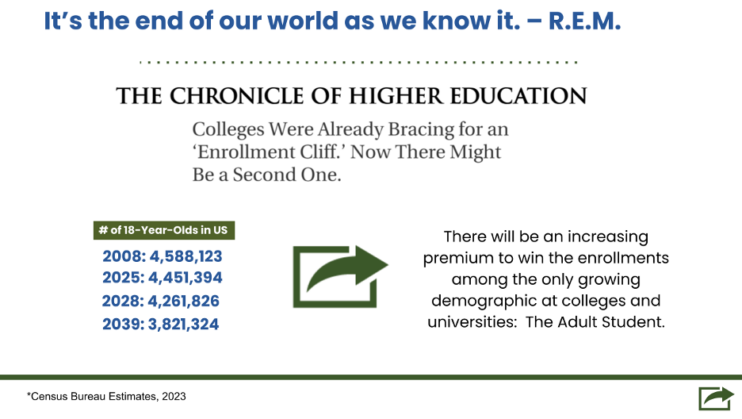The Higher Ed Enrollment Cliff: What 280,000 Surveys Tell Us

The 2025 enrollment cliff is real and more than a demographic blip: it’s a siren of profound changes in higher education.
The Challenge
As the traditional college-going population declines, we must look beyond the numbers to understand the shifting attitudes and expectations of potential students and we must look beyond the traditional high school student to the growing pool of adult learners to refill prospect pipelines. According to the National Center for Education Statistics, students older than 25 accounted for 23% of the undergraduates who enrolled in the U.S. in fall 2022 and that number is growing.
Workforce needs, the desire to create a better life, and later decisions to finish their degree are some of the reasons adult learners return to or continue their education. Yet they are hard to find and harder to attract, unlike the traditional student who lurks in high school auditoriums or takes college entrance exams. Who and where are these adults and how do we recruit them to our institutions to offset our loss from the enrollment cliff?

My Experience
In my over two decades in admissions and marketing at higher education institutions across public, private, 2-year, 4-year, and career colleges, the challenge of finding and recruiting students over the age of 18 has been paramount to institutional growth. These students don’t have guidance counselors, take college entrance tests, or have parents as influencers. They are “out in the wild” and don’t look or act the way we expect prospective students to behave because they are completely different.
At Babson, Bentley, U.C. Davis, and Santa Clara University, I focused on finding adults for our graduate business programs. We recruited using GMAC lists, alumni outreach, and social media marketing geared to categories of individuals.
Then one day, I received a phone call from a former colleague who had run the Global Market Research division at Pearson Education. “Andrea,” he asked, “What if you could find adults efficiently who have intent to enroll in education in the next two years? Would that help drive your recruitment initiatives?” I was intrigued and began doing business with his company, CollegeAPP, using person-level predictive modeling techniques—created initially in the political space and now used widely in the public sector for efficient marketing outreach.
I am now convinced that MATH is the answer to finding adults to fuel institutional pipelines and keep higher education thriving. Let me share more.
How Math is the Solution
Since 2019, CollegeAPP has surveyed Americans nationwide to identify adults who intend to pursue postsecondary education and training. To understand and identify potential students, they have administered more than 280,000 surveys over four years, paired these with publicly and commercially available data sources, and modeled adult-learner demand data at the individual, regional, state, and national levels. In short, they use methods developed for political campaigns and private sector marketing to help states and higher education institutions reach students directly.
They focus on intent—identifying those who plan to enroll in postsecondary education and training—and understanding the kinds of institutions and programs that appeal to these individuals. Intent is immensely valuable for helping institutions rethink and support their programming and enrollment management outreach strategies. It also provides essential insights for policymakers and executives, assisting them in ensuring that the nation’s education system addresses student needs. Of prime importance are students historically underserved by postsecondary structures and processes, as well as those who have traditionally not had access to the wage benefits and long-term stability offered by a postsecondary credential.
When you model based on intent, institutional biases change, and you find and recruit students beyond those who are traditionally in your classroom. According to those surveys:
- Underrepresented populations are 2 ½ times more likely to have intent than mainstream populations and this approach ensures more diversity in the classroom rather than simply finding students who “look” like those already there or relying on a quota system.
- Almost 75% of adults have a low probability of intent to enroll in education—perhaps one of the most important findings.
- That leaves 25% with high intent, and it is those students on whom institutions should focus to build marketing efficiencies—another outcome from using survey data.
Key Findings from the Surveys
Below are some additional findings.
- Many adults intend to enroll in postsecondary education, but WHO intends to enroll looks different from those who are currently enrolled and targeted in traditional enrollment management models.
- Regardless of age and level of education, Black, African American, Hispanic, and Latinx respondents are more than twice as likely as white respondents to express intent to enroll.
- Men of all races and ethnicities are less likely to intend to enroll than women. White men are the populations least likely to intend to enroll in education and training. This has shifted slightly in 2024.
- Parents, those who are single, those who earn less than a family-sustaining wage, and those who are unemployed or don’t have job stability are more likely to intend to enroll in postsecondary education or training.
- Most students are interested in taking at least some of their college coursework online and more than half would like to take all their coursework online.
- Intent is a critical indicator of whether a person will go on to enroll in education and training, but theory suggests it may be insufficient to get someone to enroll.
Next Steps
Declining birth rates, changing demographics, and an increased skepticism of their value all put postsecondary institutions and the important services they provide at risk. The pandemic highlighted the importance of a national focus on increasing educational attainment at all levels, while also resulting in decreased demand. Institutional leaders know that if they continue to approach enrollment management in the same way, they are facing an historic enrollment cliff.
This survey data has the potential to reshape the discussion about which adults should be identified and actively recruited by colleges and universities. When used strategically, data can help institutions target students who intend to enroll in education and training, turn their intent into action, and transform their future economic prospects in the process. Adult learners—or one might even say the “New Traditional Student”—will drive growth in higher education and maintain the health of the most important segment of the US economy.
